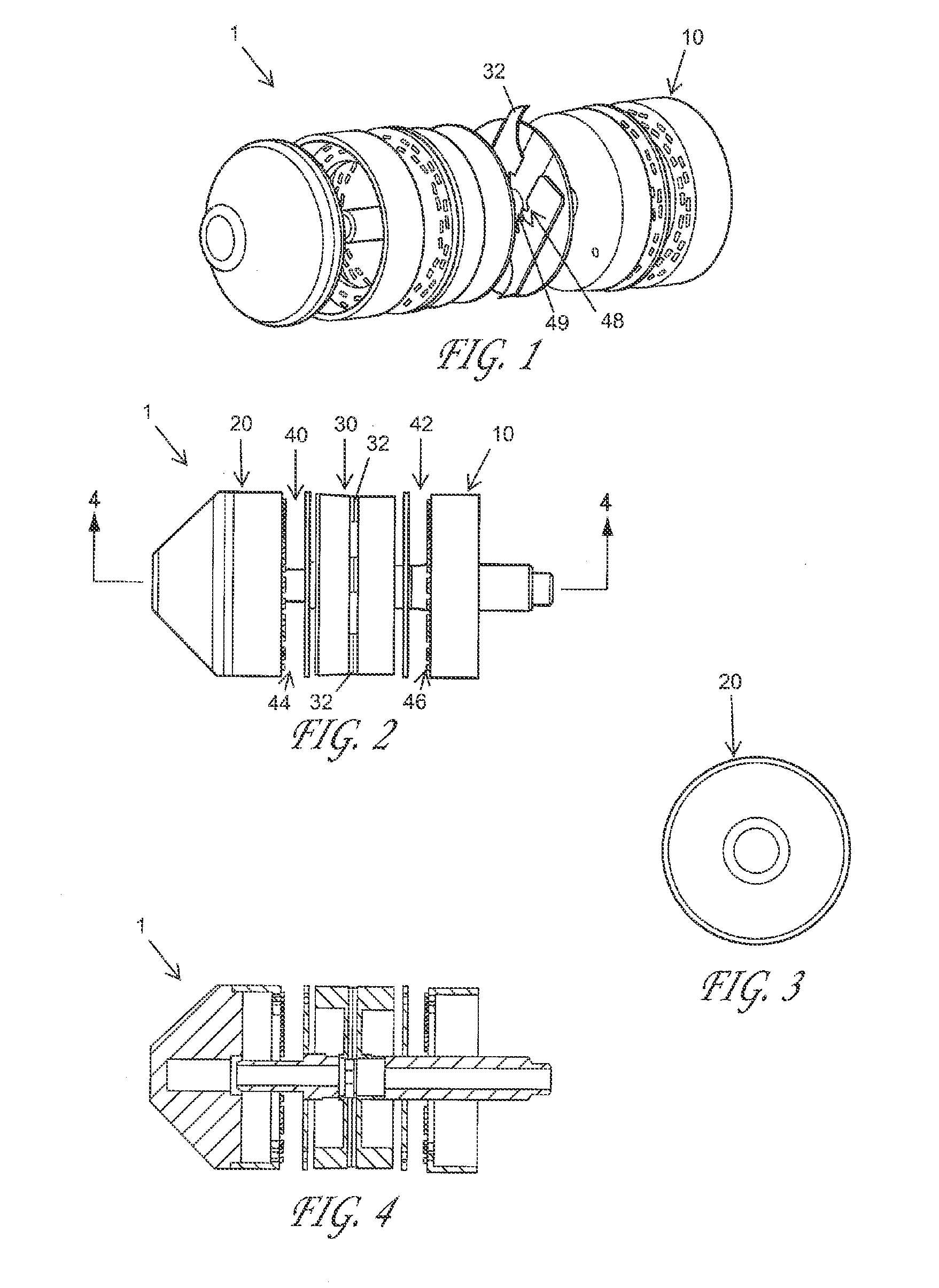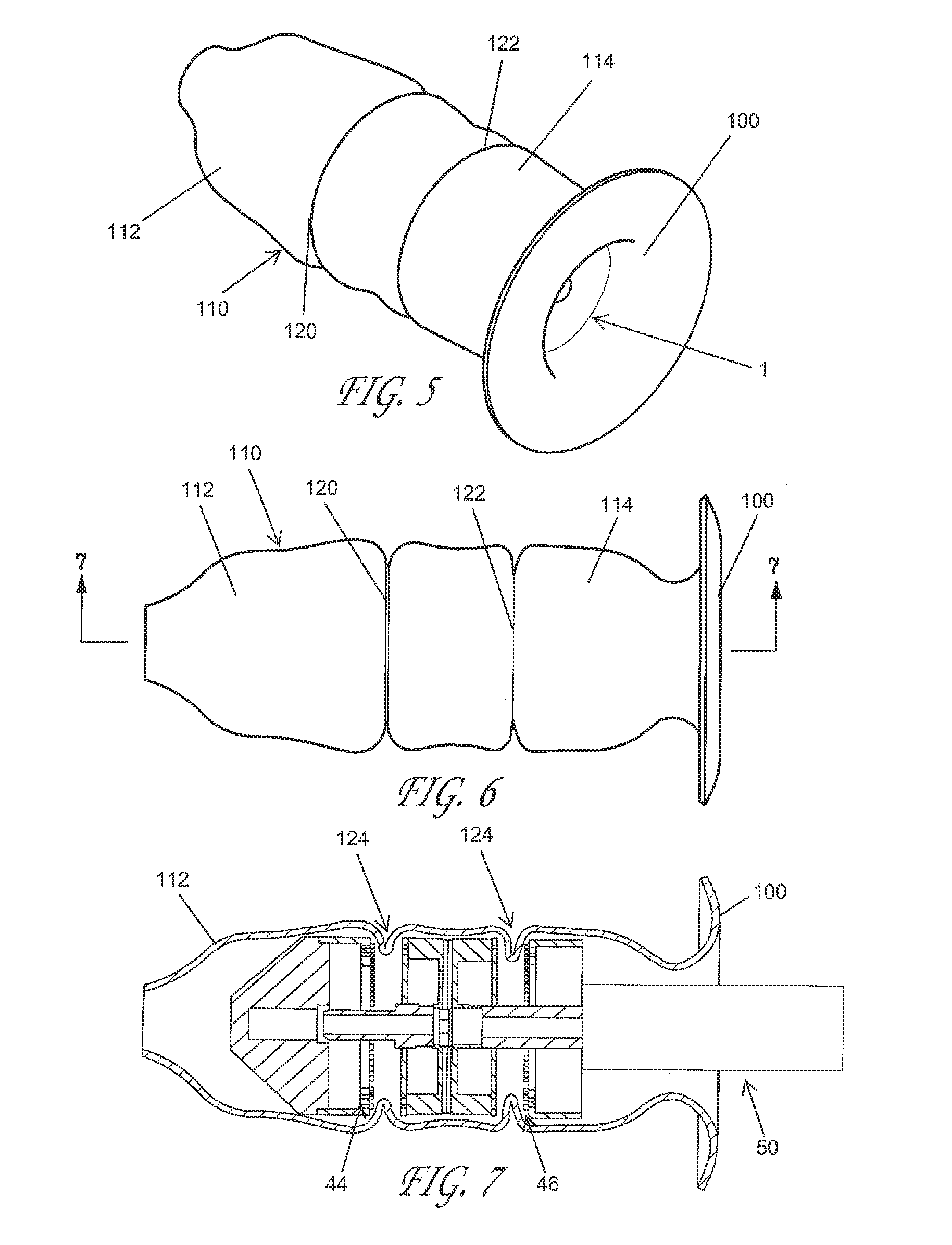Endoluminal Surgical Instrument for Stapling, Cutting and Dividing
- Summary
- Abstract
- Description
- Claims
- Application Information
AI Technical Summary
Benefits of technology
Problems solved by technology
Method used
Image
Examples
first embodiment
[0054]With reference to FIGS. 1, 2 and 18, in a first embodiment, the device 1 is generally cylindrical for inserting transanally into the rectum to the dissection position within the bowel. The outside diameter of the device must be suitable for insertion within the bowel. Preferably the rectum is enclosed within a protective sleeve (not shown) inserted laparoscopically to protect the surrounding structures during the following procedure.
[0055]The device 1 has a head portion 20, a knife portion 30 and a base portion 10. When inserted, the base portion 10 is oriented towards the anus. In an open position, two gaps 40, 42 are formed, the first gap 42 between the base portion 10 and the knife portion 30 and the second gap 40 between the knife portion 30 and the head portion 20.
[0056]In the first embodiment, the knife portion 30 includes knife blades 32 that in a retracted position are contained within the body of knife portion of the device. The knife blades can be extended from the k...
second embodiment
[0066]In a second embodiment, the device 200 contains two primary components, a head portion 220 and a base portion 210. As with the first embodiment, the device is inserted into the anus and positioned within the rectum 114 near the portion that is to be removed—see FIG. 8. The device may be inserted into the rectum in a closed position.
[0067]With reference to FIG. 9, the device includes a head portion 220 and a base portion 210. The base portion 210 is oriented towards the anus. Once in position, the device may be manipulated into an open position. In an open position, three ligature detents are exposed 212, 214, and 216.
[0068]A first ligature 224 is applied to the rectum in alignment with the middle detent 214 in the device as illustrated in FIG. 10. The ligature 224 secures the bowel 114 around the device 200. Second 222 and third 226 ligatures are applied to the rectum 114 in alignment with the first 212 and third 216 detents as illustrated in FIG. 11. The second and third liga...
third embodiment
[0078]In a third embodiment, an external clamping ring is applied to the device 300 as shown in reference to FIGS. 21A through 21H.
[0079]In this embodiment, the device is inserted transanally in a closed position. The device is positioned within the bowel near the area to be removed and expanded into an open position revealing a single detent 310 between a head portion 315 and a base portion 305. A single ligature 312 may be placed around the bowel in alignment with the single detent as illustrated in FIG. 21C. The ligature secures the bowel 114 against the detent 310 of the device 300.
[0080]With reference to FIG. 21D, a clamping ring 320 is placed around the bowel 114 and device 300 constraining the bowel 114 against the device 300 at the detent 310. At least a portion of clamping ring 320 may fit between the head 315 and base 305 portions of the device 300 in the detent 310. In this way the clamping device 320 may act as an anvil for stapling assemblies contained within the base p...
PUM
 Login to View More
Login to View More Abstract
Description
Claims
Application Information
 Login to View More
Login to View More - R&D
- Intellectual Property
- Life Sciences
- Materials
- Tech Scout
- Unparalleled Data Quality
- Higher Quality Content
- 60% Fewer Hallucinations
Browse by: Latest US Patents, China's latest patents, Technical Efficacy Thesaurus, Application Domain, Technology Topic, Popular Technical Reports.
© 2025 PatSnap. All rights reserved.Legal|Privacy policy|Modern Slavery Act Transparency Statement|Sitemap|About US| Contact US: help@patsnap.com



